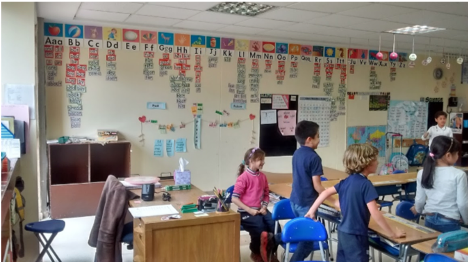Recognising the Different Ways Boys Learn
Boys and girls are different. They play differently, relate differently, even develop differentl y. While little girls are practicing their newly found language skills, chattering away to whomever will listen, little boys are busy climbing on things and racing cars—delighting when there is a big crash with a lot of noise. Anyone who has ever worked with young children will attest to these obvious differences. And yet, despite these clear differences, our classrooms are often set up to treat both male and female learners the same. Why is this, and what can we do to address it?
y. While little girls are practicing their newly found language skills, chattering away to whomever will listen, little boys are busy climbing on things and racing cars—delighting when there is a big crash with a lot of noise. Anyone who has ever worked with young children will attest to these obvious differences. And yet, despite these clear differences, our classrooms are often set up to treat both male and female learners the same. Why is this, and what can we do to address it?
After years of parenting boys and working in schools, Canadian educator Dr. Edmond J. Dixon decided to research these questions. He’s complied his findings in the book Helping Boys Learn and on the website of the same name.[1] He outlines six “secrets” to helping boys succeed in the classroom. According to Dr. Dixon, teachers and parents who recognise and employ these secrets can help boys find significant successes in the classroom and can counter some of the disengagement that has become typical for some male students.
So what are these secrets? Check them out below:
1. Movement: A boy’s brain is hardwired to detect and engage in movement. He is made to move. When movement is limited (as in the typical classroom), a boy may find creative—or destructive—ways around this. Finding ways to move is one way boys try to engage and stimulate their brains—particularly if they find themselves feeling bored. This may explain why movement-based offenses are the leading cause of behavioural issues in young boys .
.
2. Games: Boys love games. When a boy is engaged in a game, he is being given a constructive opportunity to move, to test his own abilities against those of another, and to forge a sense of shared purpose with those against whom he is competing. Because of their competitive nature, boys pay attention to games, and their outcomes. A win or loss in a game may affect a boy’s ability to concentrate on other tasks at hand until he has had a chance to process the emotions attached to the game’s outcome.
3. Humour: Like with games, a boy may use humour to engage and connect with other people and with his own emotions. Crude and slapstick humor connects to a boy’s fascination with movement. Humour also delights boys when it introduces an element of surprise. Whether or not it is appreciated, boys will include puerile humou r in their interactions and writings because they know that their peers will understand and laugh with them.
4. Challenge: Like George Mallory, boys seem to crave a challenge simply “because it is there.”[2] How a boy responds to the challenge will often relate to three factors: his belief in having adequate personal resources, the way the challenge has been framed, and how closely the challenge relates to his own goals and interests. When this secret is harnessed for learning, it can become a powerful force for engagement. When it isn’t, it can lead to power struggles or checking out.
5. Mastery: Many of the activities that boys are drawn to require mastery of complex skills—often requiring movement. Boys seem to draw a strong sense of self-worth from their ability to master these skill sets, and they want to accomplish this on their own, without the outside help of a teacher or other adult. However, if a boy believes that he is unable to master a skill—something that often occurs in school—he will often quit trying or simply turn the situation into a power struggle where he can at least “master” the situation, if not the skill itself.
6. Meaning: For boys, meaning is often connected to utility and service. Boys want to contribute to the well-being of their community. The question why is this important often masks the deeper question, how will this make me useful to others? The less a boy understands the utility of a topic, the more likely he is to become disengaged.
By acknowledging the difference between the way boys and girls learn and restructuring our classes to meet the needs of both populations, we will create an educational environment where everyone wins.
Becky Hunsberger, M.Ed.
Coordinator of Teacher Education Services
TeachBeyond, Global
________________________________________
[1] Dixon, Edmond J. Helping Boys Learn: Six Secrets for Success in School. Barrie, ON: Wintertickle Press, 2013. Website: www.helpingboyslearn.com
[2] When asked why he wanted to climb Mt. Everest, Mallory is reported to have told the reporter, “Because it is there.”
This article was first published in OnPractice on 5 March 2014.
Photo Credits: Boys with Planes. woodleywonderworks. http://www.flickr.com/photos/73645804@N00/2502804228/; Boy Laughing. stevendepolo. http://www.flickr.com/photos/10506540@N07/3275214127/







